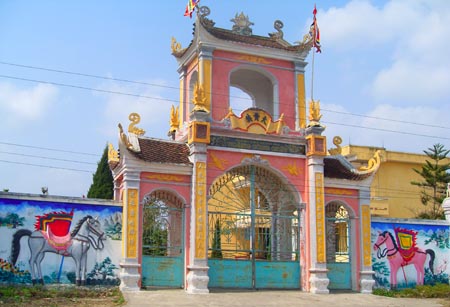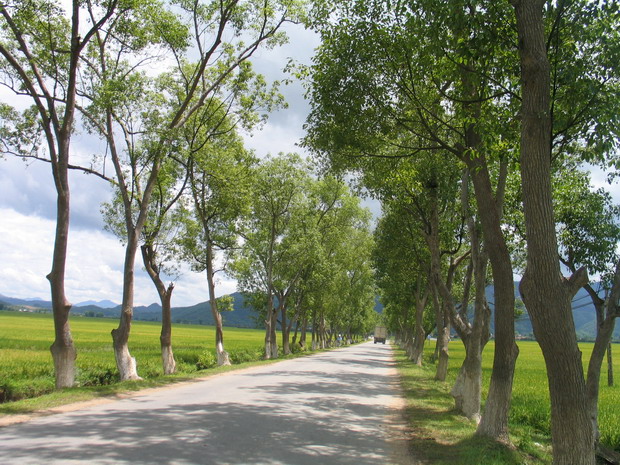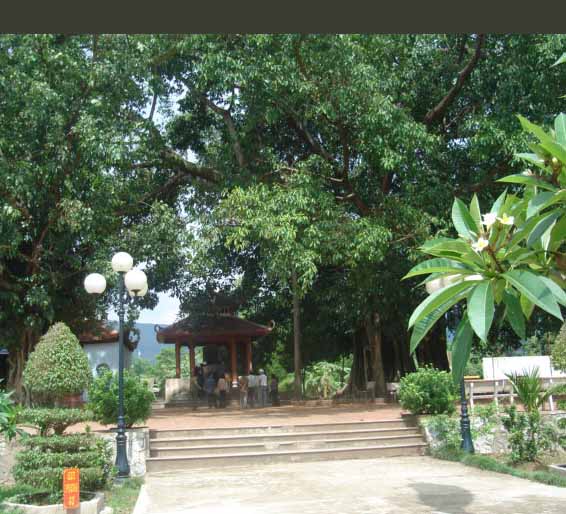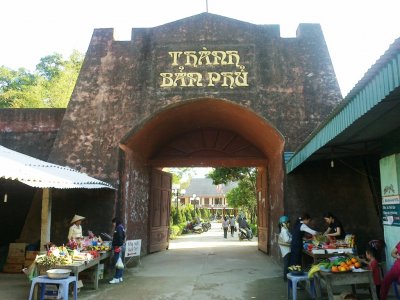Citadel of Ban Phu
About Ban Phu Citadel
Citadel of Ban Phu
Hoang Cong Chat is proud of his hometown Thai Binh
Hoang Cong Chat, also known as Hoang Cong Thu, was born in Hoang Xa village, Nguyen Xa commune, Vu Thu district, Thai Binh province (today). He was born in the early 18th century and died in 1768, this was the period when the country witnessed the Trinh – Nguyen conflict, the people’s life was extremely chaotic. Coming from a family with a patriotic tradition, supporting the king to kill foreign invaders (currently in the Hoang family’s ancestral church in Nguyen Xa, Vu Thu still retains 3 pre-Lee-time kings ordination for them. ancestor of the Hoang family).
For every Vietnamese child, when setting foot on Dien Bien land, in addition to revisiting the complex of Dien Bien Phu historical victory battlefield relics, burning incense in memory of the heroes and martyrs who have sacrificed to save lives. In order to make the Dien Bien Phu victory shake the world in 1954, there is another very important place that in the whole journey that tourists cannot ignore, it is to visit the place of activity and resting place of Lord Hoang Cong Chat (named here). respect that the people of the Northwest ethnic groups give him). This is the Ban Phu Citadel, which was ranked as a National Monument by the state in 1981.
Located about 8km from the center of Dien Bien Phu city, Ban Phu citadel, in Noong Het commune, Dien Bien district, Dien Bien province, was built more than 200 years ago. This is the place to mark the most outstanding activities of the hero Hoang Cong Chat. He is a symbol and belief for the spirit of national unity, patriotism, and resistance to foreign invaders in our country in the 18th century.
History records that in the early years of the 18th century, there appeared the Phe invaders, known as the yellow flag invaders, a remnant of the Thai Binh Thien Quoc uprising in Yunnan China in the 18th century, they were very strong and invincible. cruel, from the North to the Muong Thanh area, looting and killing good people. At the head of the grass invaders was General Pha Chau Tin Toong, a theory called Pha Chau Tin Toong (heavenly general). When they captured Muong Thanh around 1740, they stationed in Tam Van citadel, then looted everywhere as far as Thuan Chau (Son La).
Before the crimes of the Phe enemy, the people of the ethnic groups in Muong Thanh were extremely angry, in the midst of which, two people stood up and plotted to chase the Phe enemy to save the people and save the Muong. It was Mr. Ngai and Mr. Khanh (Lo Van Ngai, Lo Van Khanh), two Thai leaders, who came from a poor family in Muong Sai (Son La) to Muong Thanh to set up a career. In combination, leaders of ethnic groups in Muong Thanh fought against the enemy, but the insurgent army led by the two men suffered many losses and had to withdraw to the high mountains to preserve their forces.
The road to the castle
Banyan Tree of Phu
City Palace
In 1751, he heard that there was a general from the region who was from the upland region, stationed in upper Laos (provinces bordering Dien Bien). General Ngai and General Khanh went to meet and associate with Hoang Cong Chat’s insurgent army. Hoang Cong Chat’s uprising at this time faced many difficulties in the Son Nam Ha region before the oppression of the court, the insurgent army had to temporarily flee to the upper Thanh Hoa region and then to the upper Laos to consolidate and build up their forces.
While General Ngai and General Khanh came to Hoang Cong Chat, he decided together with General Ngai and General Khanh to lead the insurgent army along the mountain road of Song Ma to liberate Muong Thanh. The first base of the insurgent army was located in Song Ma district (Son La). Here, the insurgent force was replenished every day, when the force was strong, Hoang Cong Chat and General Ai Khanh led the insurgent army and people of all ethnic groups, united and marched towards the siege of Tam Van (Citadel). built by the Lu lords – an ethnic minority in the Northwest since the 11th century and was occupied by the Phe invaders).
From 1751-1754 many fierce battles took place in a row, our insurgent army both surrounded Muong Thanh and developed more forces, although the enemy’s position was very strong, they had cannons, but with a spirit of solidarity. one heart, fighting bravely and cleverly. General Ngai and General Khanh plotted for Hoang Cong Chat to use the Laotian and Thai insurgents to disguise themselves as soldiers of Pha Chuu Tin Toong to infiltrate the citadel, then plot inside to attack, outside to attack.
Faced with the strong and unexpected attack of the insurgents, they were unable to keep up. The enemy generals fled the citadel and fled to Pu Vang (the foothills of Doc Lap hill – a place entered into the poetry of To Huu in the 1954 Dien Bien Phu victory), where they gathered the remnants of the army, but our insurgents pulled came to defeat the invaders who captured Pha Chau Tin Toong alive and liberated Muong Thanh completely.
After defeating Phe enemy in 1754, Hoang Cong Chat stationed troops in Tam Van citadel to build Muong Thanh area into a permanent base. In 1758, Hoang Cong Chat decided to build Ban Phu citadel, a stronger and more solid fortress than Tam Van bar as the capital of the insurgent army. In 1762, after 4 years of construction, Ban Phu citadel was completed, the citadel leaned back. Entering the Nam Ron River, the outside of the citadel is surrounded by a deep moat, the foot of the citadel is 15m wide, the face of the citadel is 5m wide and 15m high, and the outside is planted with 30,000 thorny bamboo roots brought up from the west of Thanh Hoa.
During the period from 1758 to 1762, Hoang Cong Chat insurgent army just built Ban Phu citadel and operated throughout 10 continents of An Tay government, north to Yunnan (China), south to Ninh Binh, Hoa Binh, Thanh Hoa. Hoang Cong Chat, the heroic farmer in cloth clothes, together with General Ngai and Khanh once liberated Muong Thanh, this is a beautiful image in history.
The historical and cultural relic site of Ban Phu Citadel was built in the 18th century, the traces left to this day are still valuable in many aspects of history, culture and science, although the citadel was destroyed. Much after the Trinh army entered and occupied, after the liberation of Dien Bien in 1954, the Party and State paid great attention to investing in the restoration and restoration of the works in the relic to pay tribute to the loyal army, and at the same time, this is also the point of interest. shining in the history of protecting the national border of our nation.
The Ban Phu citadel is also a testament to the struggle of the people of different ethnic groups under the command of Hoang Cong Chat to defeat the Phe enemy, capture the enemy general Pha Chau Tin Toong, and liberate Muong Thanh to protect the mountains and forests. Northwestern border of the Fatherland in May 1754. Then 200 years later also on May 7, 1954 at Dien Bien Phu (old Muong Thanh) the People’s Army of Vietnam led by General Vo Nguyen Giap defeated the army. France captured General Descarri alive.
For the Phe enemy, they massacred our people in Tong Khao (white-bones bronze), and the French invaders massacred the people in Noong Nhai, these crimes will forever be remembered to remind future descendants of their sense of conservation. defense of the country.
The relic also shows the spirit of great national unity, under the leadership of Hoang Cong Chat, the people of all ethnic groups here united with one heart to chase the common enemy out of the country’s borders, together building Build Ban, Muong is full of happiness.
The monument is also a great revolutionary school, a place to propagate and educate generations of Vietnamese people about the heroic tradition, a long-standing tradition of the Vietnamese nation. The sacrifices of the people here for the sovereignty and territorial integrity of Vietnam will forever be recorded in the most glorious golden pages of history.
Hoang Cong Chat, an excellent son of Thai Binh homeland, made the honor, history and tradition of the rice country, and 200 years later another excellent son of Thai Binh was Captain Ta Quoc Luat of the 312th Battalion. , a high mirror of the flag of decisive victory on the roof of the Do Cat tunnel in the heroic battle of Dien Bien Phu.
Coming to Dien Bien Phu in the early spring days, visitors cannot help but be surprised by the unique beauty of the border city, which is the white Ban flowers like the beauty of a Thai girl in a fairy tale. about flowers. Another special thing is that the majority of the city’s population is Thai Binh, whose children followed Hoang Cong Chat’s time, after liberation in 1954 and even now that flow is still continuing.
Source: Collected internet.






